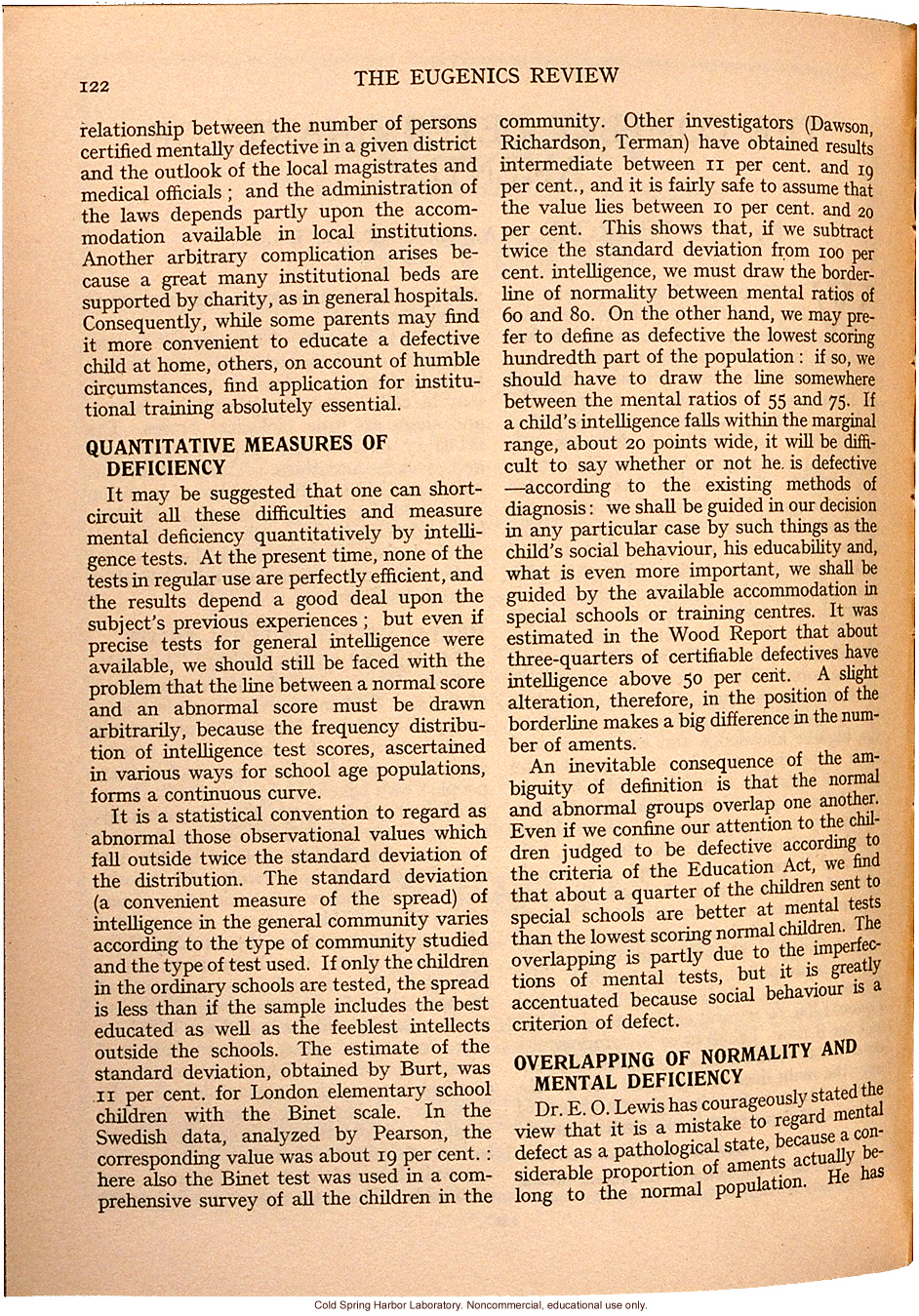122 The Eugenics Review
relationship between the number of persons certified mentally defective in a given district and the outlook of the local magistrates and medical officials; and the administration of the laws depends partly upon the accommodation available in local institutions. Another arbitrary complication arises because a great many institutional beds are supported bvy charity, as in general hospitals. Consequently, while some parents may find it more convenient to educate a defective child at home, others, on account of humble circumstances, find application for institutional training absolutely essential.
Quantitative Measures of Deficiency
It may be suggested that one can short-circuit all these difficulties and measure mental deficiency quantitatively by intelligence tests. At the present time, none of the tests in regular use are perfectly efficient, and the results depend a good deal upon the subject's previous experiences; but even if precise tests for general intelligence were available, we should still be faced with the problem that the line between a normal score and an abnormal score must be drawn arbitrarily, because the frequency distribution of intelligence test scores, ascertained in various ways for school age populations, forms a continuous curve.
It is a statistical convention to regard as abnormal those observational values which fall outside twice the standard deviation of the distribution. The standard deviation (a convenient measure of the spread) of intelligence in the general community varies according to the type of community studied and the type of test used. If only the children in the ordinary school are tested, the spread is less than if the sample includes the best educated as well as the feeblest intellects outside the schools. The estimate of the standard deviation, obtained by Burt, was 11 per cent. for London elementary school children with the Binet scale. In the Swedish data, analyzed by Pearson, the corresponding value was about 19 per cent.: here also the Binet test was used in a comprehensive survey of all the children in the community. Other investigators (Darwin, Richardson, Terman) have obtained results intermediate between 11 per cent. and 19 per cent., and it is fairly safe to assume that the value lies between 10 per cent. and 20 per cent. This shows that, if we subtract twice the standard deviation from 100 per cent. intelligence, we must draw the borderline of normality between mental ratios of 60 and 80. On the other hand, we may prefer to define as defective the lowest scoring hundredth part of the population: if so, we should have to draw the line somewhere between the mental ratios of 55 and 75. If a child's intelligence falls within the marginal range, about 20 points wide, it will be difficult to say whether or not he is defective - according to the existing methods of diagnosis: we shall be guided in our decision in any particular case by such things as the child's social behavior, his educability and, what is even more important, we shall be guided by the available accommodation in special schools or training centers. It was estimated in the Wood Report that about three-quarters of certifiable defectives have intelligence above 50 per cent. A slight alteration, therefore, in the position of the borderline makes a big difference in the number of ailments.
An inevitable consequence of the ambiguity of definition is that the normal and abnormal groups overlap one another. Even if we confine our attention to the children judged to be defective according to the criteria of the Education Act, we find that about a quarter of the children sent to special schools are better at mental tests than the lowest scoring normal children. The overlapping is partly due to the imperfections of mental tests, but it is greatly accentuated because social behaviour is a criterion of defect.
Overlapping of Normality and Mental Deficiency
Dr. E.O. Lewis has courageously stated the view that it is a mistake to regard mental defect as a pathological state, because a considerable proportion of aments actually belong to the normal population. He has
[end]


